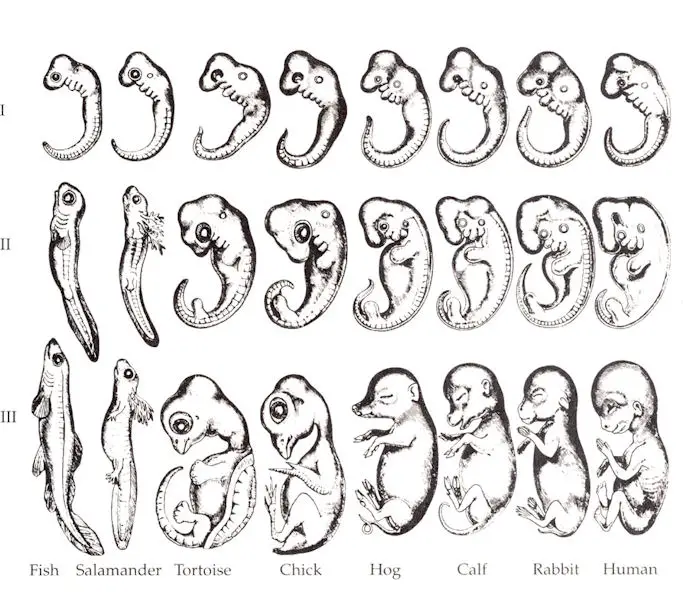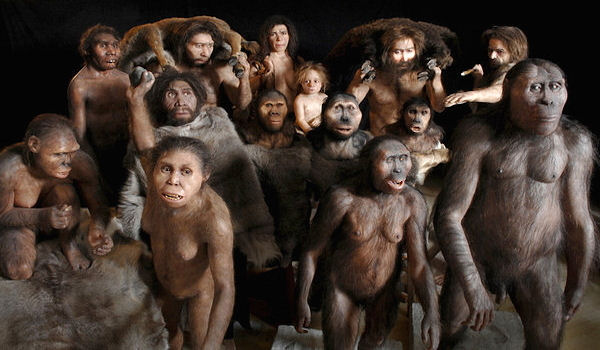
 30th March 2016
30th March 2016
By Sayer Ji
Contributing Writer for Wake Up World
The human obsession with nakedness constitutes a multi-billion dollar industry unto itself (pornography), but the fact that, among hundreds of different primates, we are the only one that is almost completely hairless, is rarely if ever considered. Indeed, understanding human nakedness may help to unlock the timeless enigma of how and where our species originated.
Nakedness and the Mystery of Human Origins
Have you ever considered the curious fact of human hairlessness? Except for facial hair in men, and scalp, underarm, and pubic hair in both men and women, we are alone among primates in having lost our protective and heat-conserving coat of hair. While I’m certain some may contend nakedness was a default human condition, beginning with original sin in the Garden of Eden, the evidence of biology is hard to ignore (after all, we all live in this highly enigmatic body). Take embryogenesis as an example…
It is simply amazing that the embryo undergoes developmental phases that recapitulate the morphological evolution of our species over millions of years. Known as ontogeny recapitulates phylogeny, a fancy way of saying the development of the individual repeats the development of the species as a whole, the human embryo moves through the following developmental phases: single-celled, aquatic (with rudimentary, fish-like gill slits), reptilian, rodent-like phases, and then moving through a simian phase near the end of gestation sporting a layer of downy fur known as the lanugo, which the fetus sheds about a month before birth. On rare occasions the lanugo is retained briefly after birth, as depicted below.
Fetal whales and dolphins (rare examples of aquatic mammals) also develop lanugo, indicating that in a preceding terrestrial evolutionary phase they were, like humans, also covered in fur. Evolution builds off preceding stages of physiological accomplishment, and our bodily form, whether it conflicts with our religious or philosophical precepts or not, tells a very compelling story of billions of years of biological evolution, adaption, and survival. The extremely non-arbitrary physiological construction of the human body, wrought over the glacial scale of biological time, cries out for an explanation. And so, hairlessness provides a powerful clue to the perennial and largely unresolved question of human origins. The fact that humans have not yet answered basic questions of physiology, such as why we have ten fingers and toes, or, why we no longer have hair, speaks to the relatively infantile stage of self-understanding our species is still presently moving through.
What We Think We Know About Human Hairlessness
Since the time of Charles Darwin, and no doubt long before, the nakedness of our default bodily condition has been a matter of intense speculation. Darwin suggested that hairlessness may have been a factor in sexual selection: the less hair, the more attractiveness, noting also the curiosity that women have less hair then men.
A far more complex and I believe compelling explanation was provided by Elaine Morgan, the feminist biologist, with her Aquatic Ape theory. Namely, it was the sudden flooded state of the African savannah about 7 million years ago that lead our pre-human hairy ancestors (not unlike what happened to our mammalian relatives the dolphin and whale when they decided to go backto the ocean) to either die or adapt to an semi-aquatic environment, where the loss of body hair, control of breathing (for diving, and eventually speech), increased subcutaneous body fat (humans are the fattest primates), capacity for water birth, etc., provided a series of survival advantages.
Incidentally, modern genetic analyses indicate that the mutation for hairlessness appeared sometime around 6 million years ago in a pre-human lineage.
Several more recent hypotheses suggest that the hairless mutation was a driving force of humanization from a human-ape common ancestry, either by enforcing upright walking (bipedalism) while holding a baby with both hands, or through encouraging romantic attraction in our species in what has been called the “naked love theory,” summarized below:
“This theory locates the origin of human hairlessness in the ancestral mother–infant relationship. In this view, hairlessness is ultimately the adaptive consequence of bipedalism. Because of bipedalism, ancestral infants lost their prehensile feet and thus lost the ability to grasp the mother’s fur with their feet, as do other primate infants. Early bipedal mothers were thus under pressure to carry the infant. Therefore infants survived only if mothers had a strong desire to hold them. Because of the pleasure of skin-to-skin contact, the desire to hold the infant would have been stronger in mothers possessing a hairless mutation that enabled them to give birth to hairless infants. Survival of these infants would have then been greater than that of hair-covered infants. The hairlessness that began to appear in this context of maternal selection was then reinforced by sexual selection in the male–female sexual relationship. This is because a hairless sexual partner would have enabled the hairless individual to recreate the pleasure of skin-to-skin contact in the mother–infant relationship. This theory then helps to explain the evolutionary origins of romantic love.”
There are many more proposed explanations floating around. For instance, some have theorized that the loss of most of our body hair enabled us to evolve more sweat glands, which made possible greater self-regulation of our bodily temperature. Others contend that hairlessness enabled our nervous system, via our exposed and more sensitive skin, greater access to environmental cues, giving us a critical edge that would eventually lead us towards attaining our apical position on the food chain, as the world’s deadliest predator. But these latter two explanations are weak, since no other example of this kind of adaption exists among primates, and few among mammals. Also, creatures that must expend a great deal of energy to produce their own body heat, and who must face drastic fluctuations in ambient temperatures, pay a steep price for losing their insulating fur. Within this context, the mutation for hairlines would have had to have provided a significant, and near immediate set of benefits to have been positively selected for, enabling it to undergo a species-wide genetic sweep to become a dominant trait.
What could have been behind this? Perhaps the answer lies within dimension of human physiology known as cellular bioenergetics, i.e. the energy flows and requirements of the human body. While elements of the aforementioned evolutionary explanations for hairlessness may retain validity, and likely may have participated in the transition to nakedness, the primary biological motivation and justification for the development of human hairlessness may be in how nakedness made available a much larger quantity of energy to the body, and particularly, the energy-hungry brain.
A Compelling New Explanation for Human Hairlessness: Enabling Humans To Harvest Sunlight As Food?
A new paper published in Medical Hypothesis, titled, “Did human hairlessness allow natural photobiomodulation,”Did human hairlessness allow natural photobiomodulation 2 million years ago and enable photobiomodulation therapy today? This can explain the rapid expansion of our genus’s brain,” proposes a unique explanation to account for our status as the naked ape, along with another curious distinguishing trait of our species, namely, the relatively rapid development of our huge brains (encephalization), which is believed to have undergone rapid acceleration about 2 million years ago.
Ian Mathewson, a retired medical practitioner, writing from Brisbane Austraila, summarizes his hypothesis as follows:
“Present hypotheses to explain human hairlessness appear to be inadequate because hairlessness is not accompanied by any immediate benefit. A new, testable, hypothesis is advanced to explain our hairlessness based on photobiomodulation research, also known as low-level light therapy. This shows that red and near infrared radiation has a very beneficial effect on superficial tissues, including the brain. Random mutation/s resulting in complete hairlessness allowed early humans to receive daily doses of red and near infrared radiation at sunset. Photobiomodulation research shows this has a twofold effect: it results in increased mitochondrial respiratory chain activity with consequent ATP ‘extrasynthesis’ in all superficial tissues, including the brain. It also advantageously affects the expression of over 100 genes through the activation of transcription factor NFkB which results in cerebral metabolic and haemodynamic enhancement. It is also possible that melanin can supply electrons to the respiratory chain resulting in ATP extrasynthesis. These effects would start automatically as soon as hairlessness occurred resulting in a selective sweep of the mutation/s involved. This was followed by the very rapid brain evolution of the last 2my which, it is suggested, was due to intelligence-led evolution based initially on the increased energy and adeptness of the newly hairless individuals.”
For those who are not yet aware of the the extensive body of research on the benefits of red and near infrared radiation on biological systems, including chronic and acute disease states, it may come as a surprise to learn that these monochromatic or quasi monochromatic wavelengths of light energy are capable of stimulating so-called ATP extra synthesis, basically helping to supplement the cells’ energy requirements by ‘supercharging’ photo accepting complexes within the electron transport chain and related elements of oxphos, as well as activating and/or positively modulating over 100 genes, some of which are antioxidant and longevity promoting. Known as photobiomodulation, or low level laser therapy, these light-based interventions enact both energy and information based changes in affected tissues through non-thermal processes. This discovery that light energy can be harvested and transduced into metabolically and genetically significant energy and information truly represents a quantum leap in medicine.
In Mathewson’s hypothesis above, a random mutation for hairlessness occurring in one of our African forebearers some 2 million years ago, conferred an immediate survival advantage over his hairy relatives by enabling her body, especially her brain, to access the red and near infrared wavelengths generated by ancient African sunsets.
Mathewson elaborates further:
Source Article from http://wakeup-world.com/2016/03/30/nakedness-could-decode-the-mystery-of-human-origins/
 RSS Feed
RSS Feed















 March 30th, 2016
March 30th, 2016  Awake Goy
Awake Goy 


 Posted in
Posted in  Tags:
Tags: 













